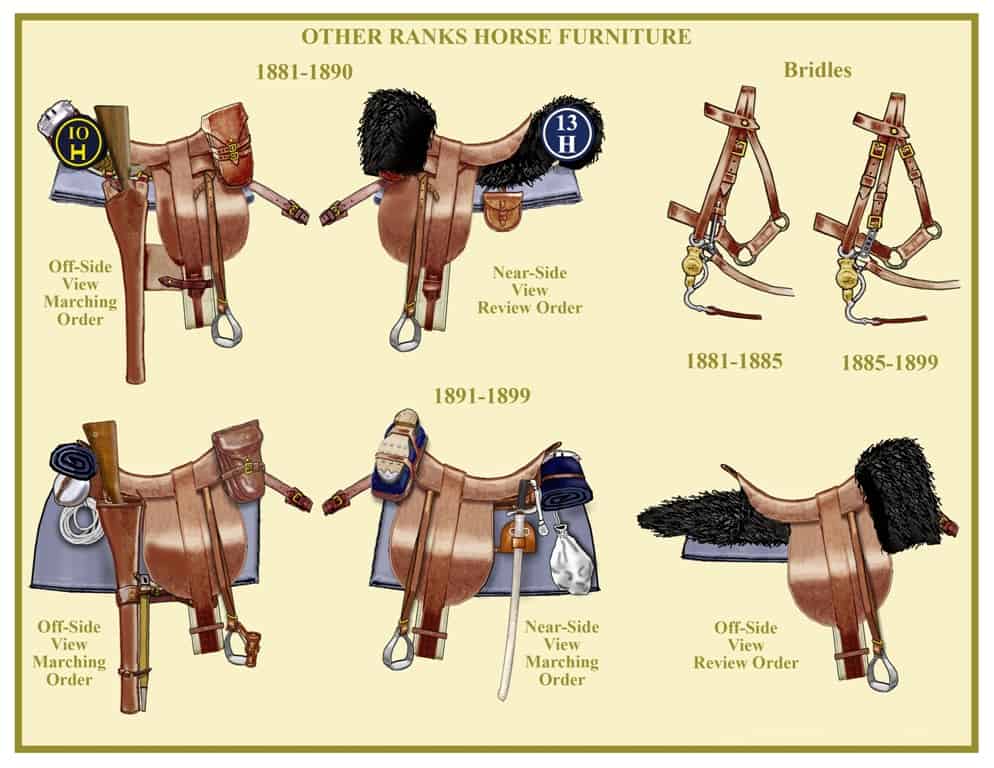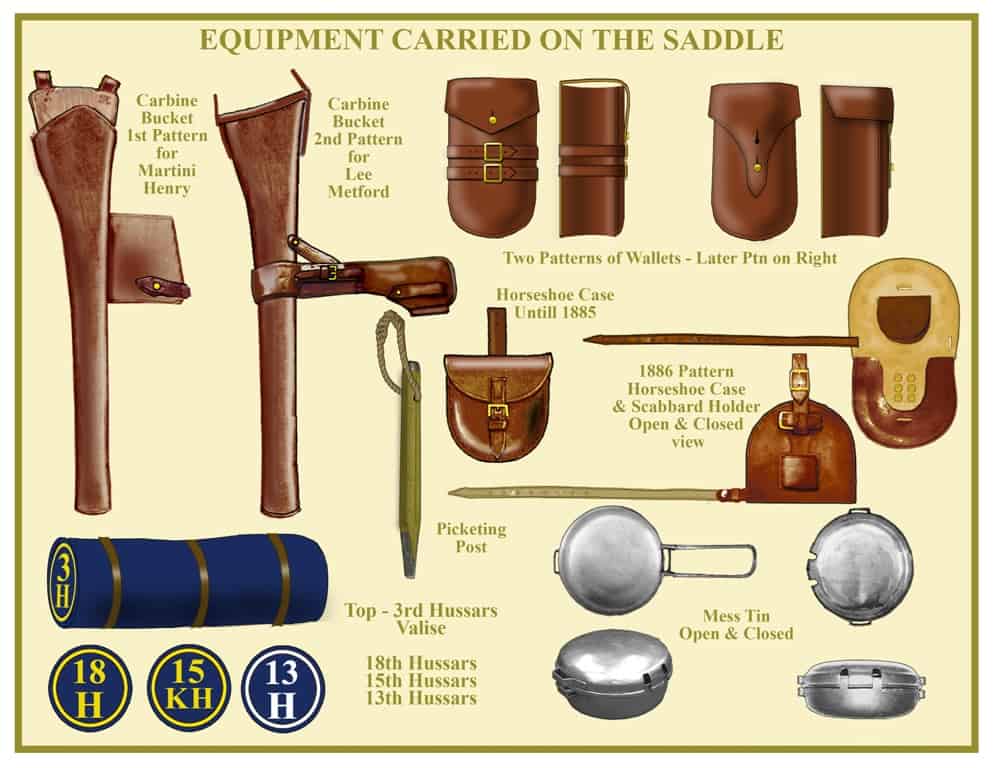OTHER RANKS SADDLES & HORSE FURNITURE
Along with other elements of the British Army’s uniforms and equipment, the development of saddlery accelerated apace during the last thirty years of the nineteenth century.
In line with the sections on weapons and equipment, the following account will not get deeply into construction and minutiae of saddlery and mounted equipment.
It will discuss the basics of the saddles introduced and let the illustrations speak for themselves.
The first universal issue saddle came from the newly created Army Board of Ordnance in 1856. Until then there had been a distinction between saddles used in the various mounted branches of the army.
The new saddle was considered very satisfactory and based on the designs of the late Captain Nolan of Balaclava fame. It was a wood arched saddle with flaps that could sustain a total weight of about 220 lbs (just over 15 ½ Stone).
It went through most of the campaigns of the 1860s and 70s and in fact was in use by many Yeomanry units at the end of the century.
The second universal saddle approved by the board was that of 1872. Known as the Flat Iron Arch saddle, it failed completely with the flat iron arches giving way easily and allowing the saddle to rest on the horse’s spine.
Thereafter followed change after change, the next being the Angle Iron Arch saddle of 1878. Trial examples of these were used by the King’s Dragoon Guards and 17th Lancers in the Zulu War of 1879 and found to be wanting. They preferred the old wood arched saddle.
Modifications in 1882 and 1884 using steel instead of iron were still unsatisfactory and during the eighties the British cavalry found itself using a mish-mash of trial patterns on service.
Finally, in 1891 the Steel Arched Universal pattern saddle Mark I was approved.
It was followed in 1893 by the Mark II and 1898 by the Mark III. All of these were a great improvement on their predecessors with a single piece seat, a higher spoon on the cantle for cavalry, wider flaps and changes to the girth with the introduction of the “V” strap.

BRIDLES
The first universal pattern bridle came in 1860 in which the snaffle bit was secured to the head collar with a T-Bar. The 1885 pattern replaced the T-Bar with a chain and buckle.
MOUNTED EQUIPMENT
The distribution of equipment on the saddle was an important factor both for the comfort of the horse and the convenience of the rider.
Beneath the saddle was a folded blanket (four folds) in grey or later brown. On the Off-Side (The riders right), the saddle carried the carbine bucket (for the Martini until 1894 and then redesigned for the Lee-Metford), the picket post and rope. On the Near-Side the horse shoe case was attached.
From about 1881 to 1885 the sword scabbard could be strapped to this case. Afterward a specially designed case was introduced. The feedbag was sometimes tied to the near side rear of the saddle.
At the front of the saddle, on the pommel were a pair of leather wallets which had replaced holsters in the middle of the century. On service ankle boots and cloak could be strapped on the wallets.
On the rear of the saddle was a valise, a tubular cloth bag, to which was strapped the canteen. The canteen was a two part metal case which could be used as a cooking pan and a bowl. It could also carry a tin cup inside.
For ceremonial purposes the sheepskin, now in two parts and black for all cavalry, was placed over the wallets in the front and over the valise in the rear.
After the valise was abolished in 1895 it was worn for ceremonial purposes only.
The horse furniture with all this equipment along with a cavalryman weighing approximately 160 lbs would come to about 220 lbs.
THE VALISE
This article of equipment had been part of a cavalryman’s kit since the early 1800s and had changed very little in the meantime.
It was made of cloth sometimes stiffened with buckram or canvas, 27 inches long and 6 ½ inches in diameter. It had an overlapping flap of 10 ins which secured it to the body with three straps and buckles.
It attached to the cantle on a “D” ring and strapped across the fans. The opening faced the rider for convenient opening and the canteen was attached to the middle strap. It was often covered by the rear part of the sheepskin which obviously kept things dry.
Its contents were supposed to be as follows. 2 pairs socks, 1 shirt, 1 pr trousers, 1 Towel, 1clothes brush, forage cap and a holdall. In 1857 the centre of the valise was hollowed out (or a void created) to ease the weight on the horses spine.
For Hussars, it was blue with designation of the regiment in yellow within a yellow circle. For the 13th Hussars it was blue with white lettering and circle. The 15th (King’s) Hussars’ was “15” over “KH” for many years.

THE CAVALRY HORSE
It seems appropriate that, given the fact that the horse was the main mode of conveyance for the cavalry, a few words about these magnificent, loyal and much abused animals should be said here.
It is difficult to imagine in these days that one hundred and twenty years ago, despite the advent of the railway, the principal manner of road transport was the horse.
It was a living being central to life on the farm and in the country and even the city. For the army it provided the motive force for moving guns, stores, equipment and of course cavalrymen in often hostile, sometimes barren, often vast areas of the world where no other form of transport existed.
Domestically, until the mid-eighteen eighties, the system of purchasing horses for cavalry regiments rested with certain officers of the regiment who had an eye for horses.
Sometimes it was the adjutant and sometimes, especially from the 1850s to the 80s it was the veterinary officer.
By 1881 the most desirable horse was the English thoroughbred which should be between 14.5 and 15 hands high and be no less than 5 years old. Officers, of course purchased their own horses, the most popular being the Hunter.
In 1887 it was finally decided to create a separate department for all matters related to remounts and the Army Remount Department was born.
Their responsibility was to purchase the horses, set the standards and prices. The quality of horse improved and the age limit was raised to six years before becoming a troop horse and a goal was set for at least 15 hands high.
Unlike heavy cavalry, hussar regiments did not try to have horses of the same hue and colour because they were much more likely to spend years overseas where it was unlikely to be possible.
When it came to overseas service, regiments often left the shores with their horses in the transports but when on campaign, local animals were taken into service and the poor horses that left Britain often died or were cast quite quickly.


